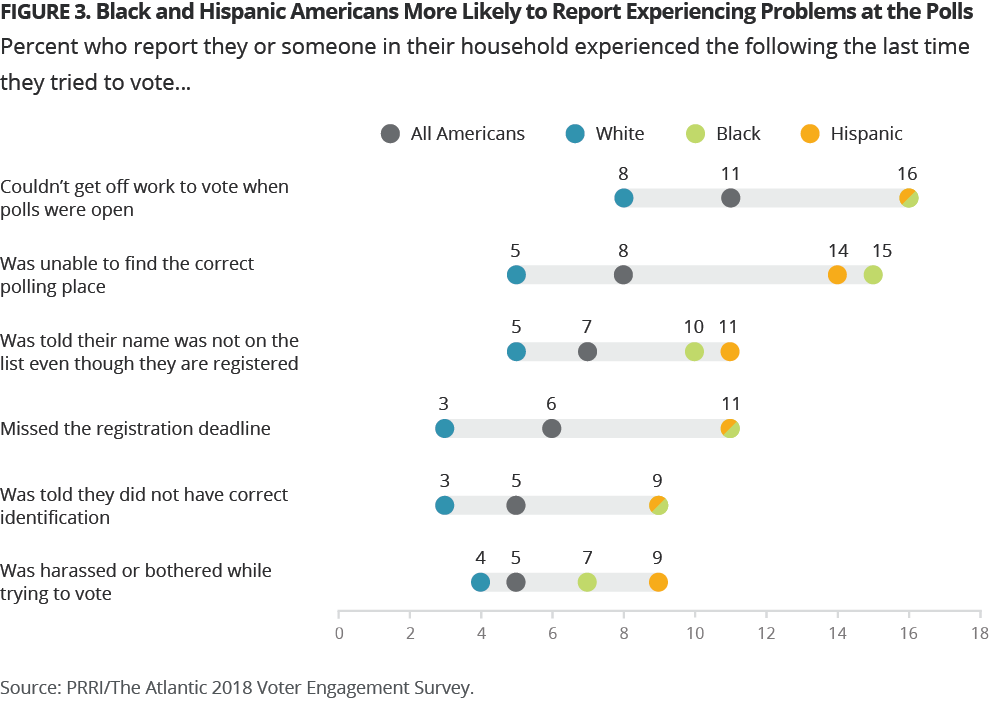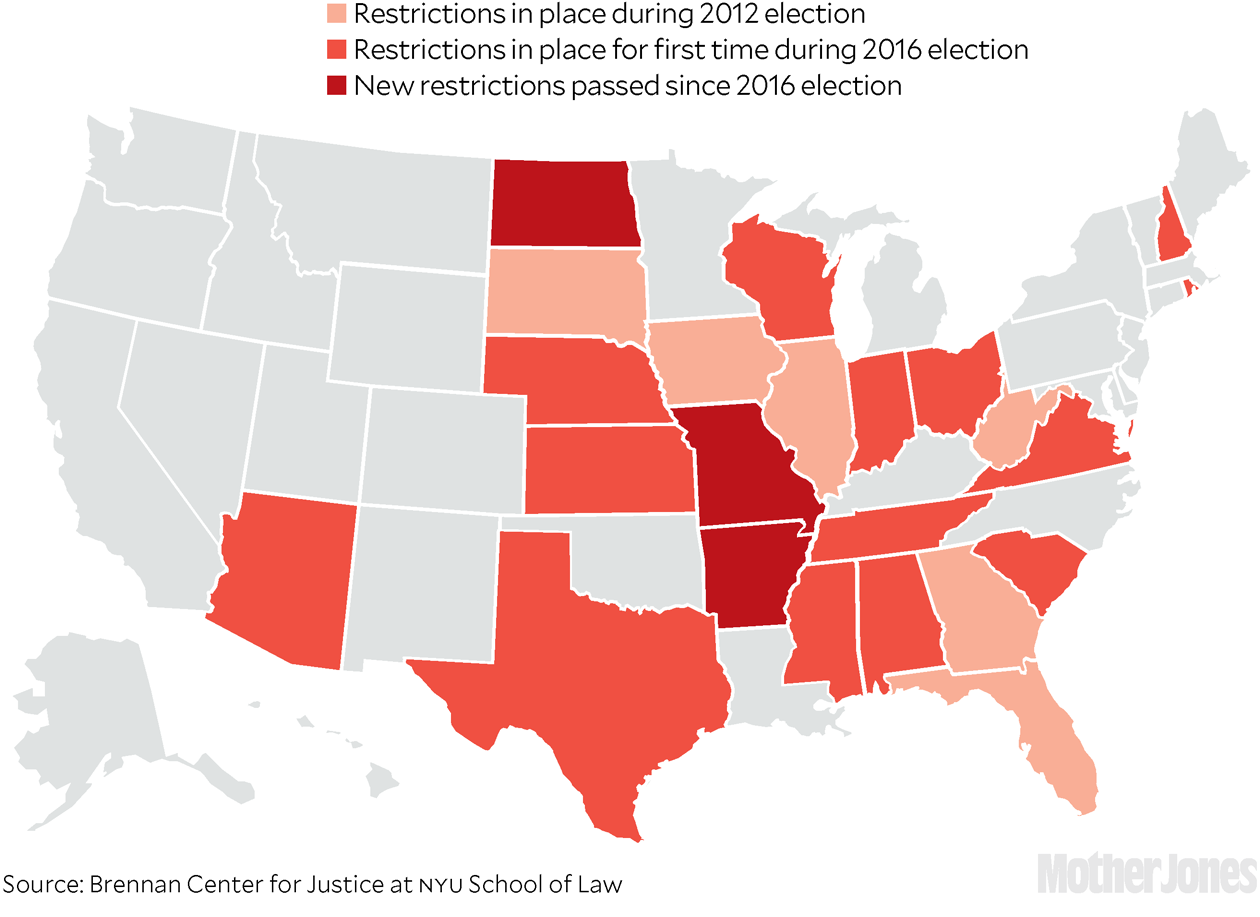
Why Voter Suppression Matters More Than You Think
Full database of sources on the Trump Election | Database entries on voter suppression
Of all the explanations offered for Donald Trump's unexpected victory in the 2016 presidential election, one of the best documented – yet least discussed in the public debate – is voter suppression. This is also arguably the one with the most immediate and substantial implications for progressive strategy before the 2018 midterm elections.
Lack of attention to voter suppression stands in striking contrast to the blanket coverage of the Russian intervention. Putin's efforts, through email hacks, social media, and more, almost certainly had enough influence during the campaign to tip the balance in critical swing states, and they warrant defensive measures to prevent a similar result in 2018. But the Republican effort to suppress minority votes was far more massive, multifaceted, and central to Republican strategy. It has been ongoing for decades, was ramped up during the Obama years, was one of the most important factors in 2016, and is a key weapon that Republicans hope to exploit in fending off a Democratic "blue wave" in 2018.
In Georgia, for example, Secretary of State Brian Kemp, who won the Republican nomination for governor in July, removed 591,548 names from the state's voter rolls in 2017. He faces a very tight race against Stacey Abrams, who would be the first Black female governor of a U.S. state should she win. A preliminary study of the names removed indicates that they are disproportionately people of color or young voters.
The term "voter suppression" covers a wide variety of actions, either targeting voters directly or changing the voting system to systematically exclude or discourage groups of voters. In targeting individuals, political campaigns may try to persuade likely supporters of their opponents that voting is useless or even risky (such as by warning immigrants or other minorities that they could be prosecuted for voter fraud). They may use dirty tricks such as distributing fake information fliers with false places or times for voting. Such tactics are as old as voting itself. But they have amped up with the addition of social media campaigns, such as those cited by a Trump campaign official only a week before the 2016 election. The unnamed official told a reporter that they had "three major voter suppression operations underway," aimed at idealistic white liberals, young women, and African Americans. Notably, these groups were also preferred targets of the parallel Russian social media efforts.
More often voter suppression refers to institutional measures imposed through laws and regulations or by officials who supervise the voting operations. These include measures to reduce the number of polling places in particular areas; reduce polling place hours and narrow the window for early voting; restrict voter registration drives and eliminate same-day registration; impose voter ID requirements that make it difficult or impossible for many citizens to register or to vote; and, especially important, remove duly registered voters from the rolls.
In recent years a flawed program called Crosscheck, purportedly aimed at preventing people from voting in multiple states, has purged voters with the same first name and last name without checking whether they are actually different people. The total purged for this reason is unknown, since detailed reports on the reasons for purges by county and state officials are not openly available. But nationwide some 15 million voters were purged from the rolls in 2014, and there is considerable evidence that those excluded are disproportionately from minority communities. Suppression also affects the counting of votes cast, from systematic mechanical failures to actual destruction of ballots from certain areas.
The cumulative effect was strikingly documented in July 2018 in a national poll of voters. For example, nine percent of black respondents and 9 percent of Hispanic respondents indicated that, in the last election, they (or someone in their household) were told that they lacked the proper identification to vote. Just 3 percent of whites said the same. Overall, the poll results showed that across just about every issue identified as a common barrier to voting, black and Hispanic respondents were twice as likely, or more, to have experienced those barriers as white respondents.
In 2016, Trump captured the Electoral College by a tiny margin of under 80,000 votes across three crucial swing states: Wisconsin, Michigan, and Pennsylvania. Had voter suppression and vote nullification not been a factor in these three states, their vote tallies – and thus the national outcome – might have been entirely different. In Wisconsin, voter ID laws removed far more Democratic voters from the rolls than the margin of Trump's victory in the state. In Michigan, votes not counted for president in deeply Democratic areas such as Detroit came to over 70,000, likely due primarily to malfunctioning voting machines rather than deliberate voter abstention from checking a choice for president.
In Pennsylvania, as well as in other states such as North Carolina, the Crosscheck program purged enough voters with questionable data to more than cover Trump's victory margin. Crosscheck, which has been extensively documented by investigative reporter Greg Palast, was built on a similar effort in Florida in the year 2000, when Florida's vote tipped the Electoral College to George W. Bush over Al Gore. Although Florida left Crosscheck in 2014, the 2016 outcome there was tilted by Florida's long-standing felon disenfranchisement law, under which citizens who have committed felonies (an estimated 1.5 million Floridians in 2016) are barred from voting for life.
For an excellent 4-minute video on Crosscheck by Greg Palast, see https://vimeo.com/180376253. Palast collaborated in a more extensive feature on Crosscheck on AlJazeera America in 2014.
A deep-rooted strategy
The present-day Republican strategy of voter suppression has deep roots in the nation's history. In the late nineteenth century, after a brief interval of voting- rights expansion during Reconstruction, Jim Crow laws and practices were put in place to bar Black voters from the polls. A hundred years later, passage of the Voting Rights Act in 1965 led the Republican Party to roll out its "Southern strategy," which used subtle and overt racist appeals to shift white Southern voters into the party's ranks. Since then, finding ways to deny votes, especially of African Americans and other minorities, has been central to the Republican Party's electoral strategy. The main actors have been Republican-controlled state legislatures and election officials, assisted in recent years by Supreme Court decisions undermining the Voting Rights Act and other protections of voting rights.
In addition to Greg Palast, cited above, journalist Ari Berman has documented these developments comprehensively. Palast's The Best Democracy Money Can Buy: A Tale of Billionaires & Ballot Bandits (http://amzn.to/2iEN3gr) and Berman's Give Us the Ballot: The Modern Struggle for Voting Rights in America (http://amzn.to/2gFkEFk) are fundamental sources – both written before the 2016 election – on the long history of voter suppression. Both writers continue their investigations and are well worth following: Palast through social media or on his website, and Berman through his articles in The Nation and other publications.
What can be done
The most important targets for action to counter voter suppression are state political systems, including legislatures, governors, attorneys general, and election officials. Notably, state governments are also the key battleground for two key parallel issues: reform of the Electoral College and redistricting for both state and federal elections. And although recent decisions by the Supreme Court have posed additional obstacles, there is still ample room for judicial challenges in both state and federal courts.
Whether or not one lives in a Republican-dominated state with acute voter suppression issues, it is important to build awareness and to press Democratic candidates and strategists to pay more attention to voter suppression in addition to their efforts to change minds and turn out their supporters to vote. The limited media coverage needs to be amplified on social media. And organizations working on the issue nationwide need more support.
Probably the most important organization focused primarily on these issues is the Brennan Center for Justice at the New York University School of Law (https://www.brennancenter.org/), which provides extensive research and advocacy resources, including on relevant court cases. The Voting Rights Project of the American Civil Liberties Union ( https://www.aclu.org/other/about-voting-rights-project) actively pursues court cases and is currently litigating cases in over a dozen states. Let America Vote (https://www.letamericavote.org/), founded by former Missouri Secretary of State Jason Kander, focuses on popular mobilization to combat voter suppression. And the Electronic Registration Information Center (ERIC) is working with its member states (24 as of July 2018) to improve the accuracy of voter rolls, as an alternative to the biased Crosscheck system.
Finally, one thing every US citizen over 18 can do right now is to check your own registration at https://www.vote.org/am-i-registered-to-vote/, and help your friends and family members do so as well. Individual candidates in vulnerable states can also alert their supporters about the need to check their voter registration well in advance of the midterms, and provide information about how to get help if there are problems.
Republican voter suppression efforts will certainly continue. But their chances of success can be reduced if Democrats and others concerned about protecting voter rights take the threat seriously and act accordingly.
****************
Go to database of sources on voter suppression.
For an overview of the database, and links to sources on other specific explanations, visit http://www.noeasyvictories.org/usa/trump-win-reasons.php.

